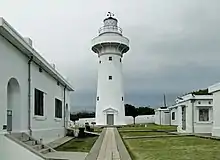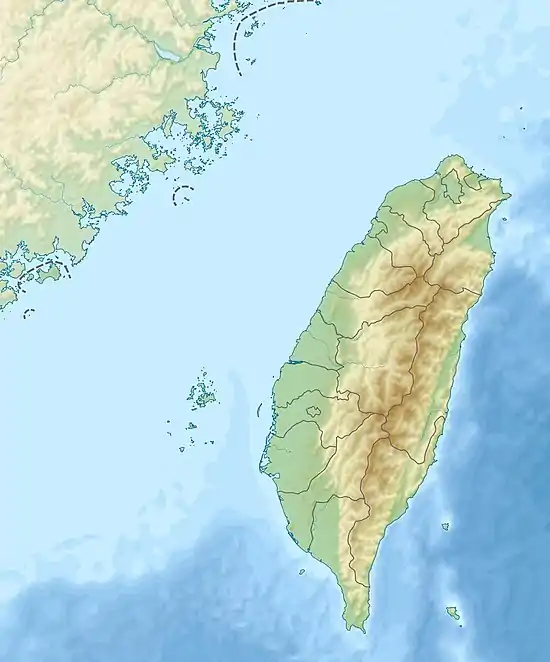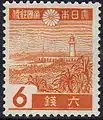Eluanbi Lighthouse
Eluanbi Lighthouse is a lighthouse located on Cape Eluanbi, the southernmost point of Taiwan, which separates Taiwan's South Bay from Banana Bay and the Taiwan Strait and the South China Sea from the Philippine Sea. It is near Eluan Village in the township of Hengchun in Pingtung County, Taiwan. The lighthouse is open to the public all year around.
 Eluanbi Lighthouse | |
 Taiwan | |

| |
| Location | Eluanbi Village Hengchun Pingtung County Taiwan |
|---|---|
| Coordinates | 21°54′08″N 120°51′09″E |
| Year first constructed | 1883[1] |
| Foundation | concrete and granite |
| Construction | cast iron tower[2] |
| Tower shape | cylindrical tower with balcony and lantern on one-story keeper's house and visitor building[2] |
| Markings / pattern | white tower, black lantern dome[2] |
| Tower height | 21.4 m (70 ft)[1] |
| Focal height | 56.4 m (185 ft)[1] |
| Original lens | Fourth order fresnel |
| Intensity | 1,800,000 candela |
| Range | 27.2 nmi (50.4 km; 31.3 mi)[1] |
| Characteristic | Fl W 10s.[2] |
| Admiralty number | P4602[2] |
| NGA number | 13768[2] |
| ARLHS number | TAI-018[2] |
| Managing agent | Maritime and Port Bureau[1] |
| Eluanbi Lighthouse | |||||||||||||
|---|---|---|---|---|---|---|---|---|---|---|---|---|---|
| Chinese name | |||||||||||||
| Traditional Chinese | 鵝鑾鼻燈塔 | ||||||||||||
| Simplified Chinese | 鹅銮鼻灯塔 | ||||||||||||
| |||||||||||||
| Japanese name | |||||||||||||
| Kanji | 鵝鑾鼻灯台 | ||||||||||||
| Hiragana | がらんびとうだい | ||||||||||||
| |||||||||||||
Names
The lighthouse is named after nearby Cape Eluanbi, the southernmost point on Formosa or Taiwan Island. The name also appears as Eluan and Eluan Pi;[2] as Oluenpi[3] and O-luan Pi from its Wade-Giles romanization;[2] and as Garanbi or Garambi from its Japanese pronunciation.
Eluanbi Lighthouse is also known as "The Light of East Asia" because its light is the most intense of those on Taiwan.[1]
History
Qing Empire
Shipwrecks were common around Cape Eluanbi in the early modern era owing to the nearby Qixingyan reefs and strong currents. The hostile native reactions to these accidents rose to the level of international incidents in the case of the Rover and a Ryukyu convoy, which prompted invasions from the United States and Japan in 1867 and 1874. In the latter case, the Qing Dynasty explicitly disavowed responsibility for native-held areas on Taiwan Island, creating a power vacuum that threatened Japanese or European colonization of the region. Following the advice of Charles Le Gendre,[4] the American consul at Xiamen (then known as "Amoy"), the Viceroy of Liangjiang, Shen Baozhen, began constructing coastal defenses to improve the situation.[5][3]
Construction of the Eluanbi Lighthouse fell under the purview of the British diplomat Robert Hart,[4] inspector general of the Imperial Maritime Customs Service. He sent agents to purchase the southern cape from the leaders of the Kuie Chia Chiao (t 龜仔角, s 龟仔角, Guīzǎijiǎo) in 1875.[4]
Construction began in 1881.[4] Although Shen largely favored French officers like Prosper Giquel,[5] Hart placed construction of the Eluanbi works under the English engineer John Ropinald[2] and architect W. F. Spindey. Wang Fulu (t 王福祿, s 王福禄, Wáng Fúlù) oversaw the project and the 500 soldiers sent to protect it.[6] Native opposition from the Paiwan and other local aboriginal tribes was severe and sustained.[6] The structure was the only armed lighthouse on the island,[1] surrounded by a 6 m (20 ft) fosse provided with caponiers and barbed-wire fencing.[7] It was riddled with gunports to allow its garrison to repel assaults. Work was finished in early 1883[1] and the tower began operation on 1 April.[5] The total cost was 71,248 Mexican dollars,[7] more than 200,000 silver taels.[6] £5,881 were used for the tower and fort; £3,223 for the light and its housing.[7] A great deal of the rest was used for dynamiting the coral around a nearby creek and constructing a 52 m (170 ft) concrete jetty for landing personnel and supplies; the jetty had proved necessary because of the difficult landing at Eluanbi's beaches owing to their heavy swells.[7]
George Taylor assisted with construction after its first year[8] and served as its first lightkeeper until 1889.[9] He maintained close relations with the Paiwan and even became proficient in their language, but was also protected by 16 Chinese soldiers under a German officer.[9] Their arsenal included two 18-pounder cannons, two Gatling guns, and a Cohon mortar;[7] and they maintained food and water provisions capable of lasting a three-month siege.[9] The station also kept a team of laborers and kitchen staff on site.[9]
The first tower was 15 m (50 ft) high and cast iron. It was 6 m (19.5 ft) in diameter at the base and 4 m (12.66 ft) at the top.[7] The lantern included revolving steel shutters to protect the glass from attack, and its gallery included gunports for rifles and one of the fort's Gatling guns.[7] The foreign staff had spacious brick bungalows whose rooms were connected by bulletproof corridors to the 4 m2 (40 sq ft) fort; they stayed in quarters inside the tower during assaults.[7] The Chinese staff lived in the fort at all times and maintained its kitchen, armory, storerooms, and underground cisterns.[7]
The garrison was later reduced to eight men.[7]
Imperial Japan
During the First Sino-Japanese War, the lighthouse was severely damaged by attack and then from sabotage by its retreating Qing garrison. After the Treaty of Shimonoseki gave Japan control of the island, colonial officials first repaired the lighthouse in 1898 and then installed a stronger light in 1910.[6]
During World War II, the lighthouse was again seriously damaged by American bombing.
Republic of China
The lighthouse was rebuilt by the Republic of China in 1947.[6] It was refurbished with a powerful Fresnel lens in 1962.[1] The surrounding Eluanbi Park opened to the public on 25 December 1982[10] and the lighthouse itself welcomed regular visitors ten years later.[1]
On the memorial to Eluanbi Lighthouse as one of the 8 Views of Taiwan, the Chinese "Eluanbi" is sculpted into the surface in Wang Xizhi's calligraphic style.
Transportation
The lighthouse is accessible from Provincial Highway 26.
Gallery
 Eluanbi c. 1934
Eluanbi c. 1934 Eluanbi on a 1939 Japanese stamp
Eluanbi on a 1939 Japanese stamp Side view (2010)
Side view (2010) Sunrise on Cape Eluanbi (2016)
Sunrise on Cape Eluanbi (2016) The view from Eluanbi (2017)
The view from Eluanbi (2017) Sunset at Eluanbi (2017)
Sunset at Eluanbi (2017)
References
Citations
- MPB (2019).
- Rowlett (2007).
- Eskildsen (2019), p. 38.
- Wang & al. (2016).
- Alsford (2018), pp. 67–8
- 鹅銮鼻灯塔, WSHNT, KUAS. (in Chinese)
- Dudbridge (1999), pp. 12–13.
- Dudbridge (1999), p. 3.
- Keller.
- KNP (2019).
Bibliography
- 鵝鑾鼻公園, Official site, Kending: Kenting National Park Headquarters, 2019. (in Chinese)
- "Eluan Pi Lighthouse", Official website, Taipei: Maritime and Port Bureau, 2019.
- Alsford, Niki J.P. (2018), Transitions to Modernity in Taiwan: The Spirit of 1895 and the Cession of Formosa to Japan, Abingdon: Routledge.
- Dudbridge, Glen, ed. (1999), "George Taylor and the Peoples of the South Cape", Aborigines of South Taiwan in the 1880s, Monograph No. 2, Taipei: Shung Ye Museum of Formosan Aborigines.
- Eskildsen, Robert (2019), Transforming Empire in Japan and East Asia: The Taiwan Expedition and the Birth of Japanese Imperialism, Singapore: Palgrave Macmillan.
- Keller, Ian, "George Taylor", 19th-Century European & North American Encounters with Taiwan: A Bibliography of Texts Input, Portland: Reed College.
- Rowlett, Russ (2007), "Lighthouses of Taiwan", Lighthouse Directory, Chapel Hill: University of North Carolina.
- Wang Shuhui; et al. (May 2016), 清末恆春地區涉外事件與鵝鑾鼻燈塔興建之關係(1867-1883), 《美和學報》, Vol. 35, No. 1, Neipu: Meiho University, pp. 29–46. (in Chinese)
External links
| Wikimedia Commons has media related to Eluanbi Lighthouse. |
- Eluanbi Lighthouse-Directorate General of Customs(Taiwan) (in English and Chinese)
